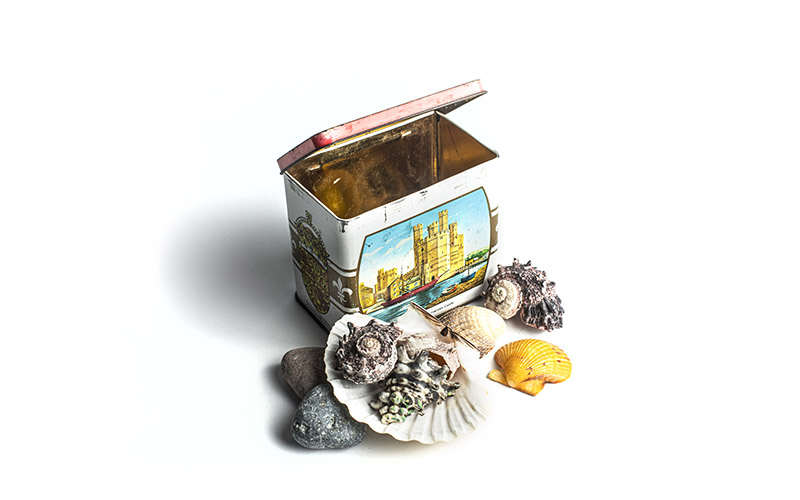Object handling for reminiscence
Often handling the most every day and domestic of objects can be most effective at sparking memories, starting conversation and finding out more about your residents’ lives and personalities.
The most effective objects are things that do something or require an action – an egg whisk or a wind-up toy, a tin box with a lid, a bar of soap.
Or things like buttons that can be sorted and examined, or toys like marbles or a spinning top.
They can also be a starting point for creative sessions of all kinds once you find out what your residents respond to.
Materials Required:
- Collect domestic objects
- Here’s some ideas for things that are easy to get hold of
- An egg whisk, an old tin box, a pipe, a bar of pears soap, wooden butter pats, a wooden scrubbing brush, a wooden spoon, a silver teaspoon, silver polish, a tin of black shoe polish, an old fashioned dressmaking tape measure, chalk and black paper.
- For a more sensory session, your objects could be herbs like lavender and rosemary collected from someone’s garden and living herbs in pots like parsley and sage from a local supermarket.
- You could bring in wildflowers collected by staff
- Shells and pebbles for a beach themed reminiscence session along with a beach ball and a windmill perhaps.
- Pine cones and autumn leaves are also great for an autumn session
Step by step guide
- Gather up your reminiscence objects and find an interesting bag, box or suitcase to put them in for the session which will get your residents curious and add to the sense of anticipation.
- If you have access to an I pad and wifi this could be used to look up songs, tunes, brands, makes, workplaces if they are mentioned and will add another dimension to your session.
- Changing the environment switch off the TV and try to use a space where there’s no other distractions or conversations
- Gather your residents around a table, if possible, for the reminiscence session. Eight is a good number. But it‘s still possible to hold the session in the lounge with more people – especially if other staff get involved too – you can also adapt it as a one to one session.
- If working with a group of residents pass one object around at a time allowing time for them to handle it and maybe even smell it, you can start with yourself and ask a simple question – what would this soap have been used for? Or did you have one of these at home?
- Try not to ask questions that can just be answered ‘yes’ or ‘no’.
Ask open questions that will encourage talk
Always be the person who doesn’t know, even if you do.
Say things like: ‘I wonder what this is?’
Ask: ‘Have you ever seen one of these?’
And: ‘Do you know how this works?’
Or ‘Shall we see what this does?’
Sharing some memories of your own can start a discussion.
- Allow each resident time and space to say something about each item as you share it
Listen to their memories, record them or write them down if you have the chance – with the resident’s permission.
Memories are sometimes linked to a tune – if you have access to an I pad or tablet you could quickly look up the song on You Tube or whatever you have access to play it on if someone starts to sing or hum a tune.
It doesn’t matter if the memories aren’t about the objects, they are simply the trigger.
Be aware that some objects may trigger sad memories too, so be sensitive to this and give residents space or stop if necessary.
Ideas for Further Activities with This Idea:
Reminiscence sessions often lead to finding out more about your residents and what they might enjoy doing and can bring with them ideas for further creative sessions.
Some examples –
Residents handling silver spoons started reminiscing about polishing the silver every week as children – so we had a session polishing silver spoons together which made the group very relaxed and chatty.
We noted down some of their memories in the polishing session.
Then followed this up by drawing around spoons and drawing spoons then adding their collected memories to create an artwork.
A session handling and smelling herbs from the garden made me realise how much some of the residents knew about herbs medicinal properties – a next step could be to make a record of their knowledge by making a note book with pressed herbs, drawings, paintings and writing which could be an ongoing activity.
An old fashioned cotton reel might remind someone that they used to make a French knitting doll, or “knitting Nancy”, out of a cotton reel by hammering 4 tacks into the top – this could lead to you bringing in a knitting doll and some balls of wool and asking if anyone can teach you how to use it. And getting everyone involved by helping to hold or sort the wool, doing some knitting together or unpicking some bad stitches and all the conversation and engagement that comes with a creative session.
Adaptability
Ways to adapt for less able residents:
Reminiscence sessions are about communication and sharing objects can be a way to communicate without the need to speak, sharing in the smell of something, showing you what’s inside, remembering a tune to hum together and feeling part of a group, taking part in a shared experience.
Ways to adapt from group to individual and vice versa:
Passing someone an interesting object to handle can be a great distraction if they’re anxious and having a selection of objects that you can use and share to communicate with someone living with dementia can be very reassuring.

